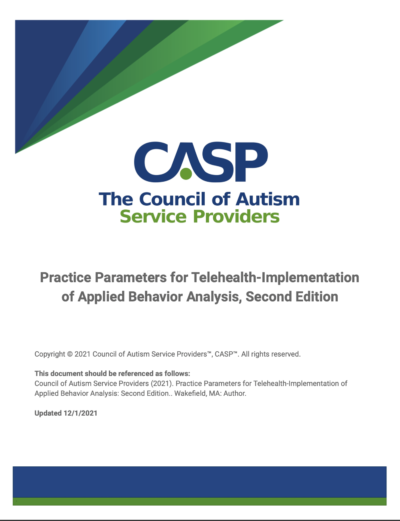Standards & Guidelines
ABA Practice Guidelines (Version 3.0)
Practice Parameters for AI Use in ABA
Practice Parameters for Telehealth ABA
(Updated December 1, 2021)
These guidelines are intended to serve as a resource for designing, implementing, and operating ABA services delivered via telehealth in a broad range of clinical settings (e.g., home, clinic, school) and to address a variety of targeted treatment goals (e.g., challenging behavior, sleeping, adaptive living skills). The purpose of this document is to serve as a clinical and technical resource for providers and ABA organizations to ensure safe, effective telehealth delivery of ABA service. A secondary purpose is to provide support and guidance to payers to develop their infrastructure and regulations for expanding access to telehealth services.
Overview
The CASP Organizational Guidelines articulate best practices for organizations providing evidence-based services to individuals with autism spectrum disorder (ASD).
Although there are resources that define best practices for individual autism service providers (e.g., Behavior Analyst Certification Board® and Association of Professional Behavior Analysts, 2019; Council of Autism Service Providers, 2020), until now there has not been a set of comprehensive guidelines for organizations.
The overarching goal of these guidelines is to fill this void and ensure that organizations committed to providing high-quality services for autistic individuals and their families are sustainable and can position themselves to increase those services and supports.
The CASP Organizational Guidelines provide recommendations regarding best-practice policies, procedures, and infrastructure to enable practitioners to consistently deliver high-quality applied behavior analysis (ABA) services.
The urgent need for high standards of care and CASP’s commitment to ensuring sustainable, effective services for clients with ASD have driven this project.
The steadily rising prevalence rate of ASD, the passage of health insurance laws recognizing ABA interventions as medically necessary for ASD in all 50 U.S. states, and the increased enforcement of state and federal mental health parity laws have created a greater demand for—and improved access to—ABA services.
This exponential growth has spurred increased regulation of those services. In view of these factors and the economic pressures of maintaining autism service provider organizations, the field of autism services has no time to waste in establishing comprehensive organizational guidelines.
The CASP Organizational Guidelines offer foundational information for the development of standards for a planned nonprofit agency accreditation program to be launched by CASP.
Who will benefit from Organizational Guidelines?
Although the CASP Organizational Guidelines are written for autism service organization owners, administrators, and providers, they are intended to benefit all stakeholders who share the goal of helping providers deliver high-quality and cost-effective services, such as direct recipients of ABA services, their families, payers, regulators, and advocates.
The focus is on the delivery of ABA services, but much of the content is applicable to organizations that provide other autism services, including multispecialty organizations.
Content Areas
The CASP Organizational Guidelines are organized in three general areas:
Business Operations. Covered topics include general business operations, such as strategic planning, human resources, and financial management. Chapters on these topics were written with autism service provider organizations in mind, but the content is not unique to the delivery of autism services.
Clinical Operations. This section covers topics specific to organizational delivery of ABA services, largely in the context of health care (e.g., organizational support for clinical excellence, documentation, telehealth).
Risk Management. Topics in this section focus on minimizing risks to clients, caregivers, providers, other stakeholders, and the autism service provider organization itself (e.g., organizational ethics, client rights, crisis management).
The CASP Organizational Guidelines were developed over several years. Each chapter has been through a detailed series of reviews and refinements.
How do the CASP Organizational Guidelines address the tremendous diversity of operational structure of autism service provider organizations?
More than 150 distinguished subject matter experts have contributed to the development of the CASP Organizational Guidelines.
This resource guide was created to help autism service provider organizations quickly resume operations following a widespread disaster, minimizing disruption of services for autistic individuals and their families.
Background
On August 8, 2023, the island of Maui experienced one of the deadliest wildfires in modern U.S. history. In its aftermath, autism service providers struggled to continue delivering critical behavioral health services like applied behavior analysis (ABA). The wildfire demonstrated the need for a practical resource to support autism service provider organizations through future disasters.
In late 2023, a group of CASP members convened a workgroup to take this on. Informed by personal experiences with the Maui wildfires and other disasters, the workgroup created this easy-to-read resource with clear, actionable recommendations. For ease of use, the content is presented in the form of bullet points, brief narratives, and customizable templates.
Scope
Adequate disaster preparedness is essential. This guide summarizes general disaster preparedness recommendations for businesses and highlights special considerations for organizations that deliver autism services. However, its primary focus is to provide strategies that address the unique challenges autism service providers face during and after a disaster.
This guide includes information about client behavior changes that can result from a disaster. However, recommendations for addressing these behaviors with modified individual programming is outside our scope here.



